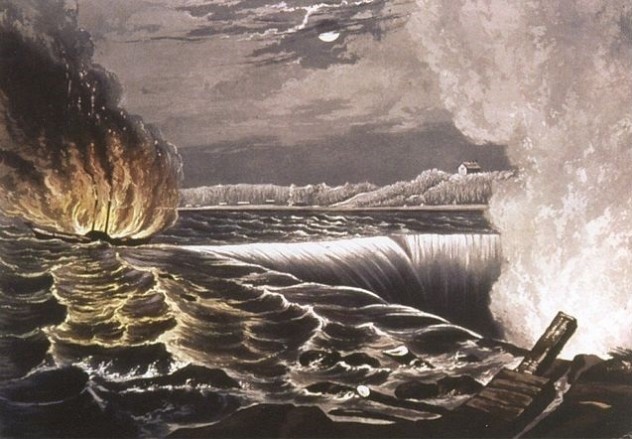 Movies and TV
Movies and TV  Movies and TV
Movies and TV  History
History 10 Things You Didn’t Know About the American National Anthem
 Technology
Technology Top 10 Everyday Tech Buzzwords That Hide a Darker Past
 Humans
Humans 10 Everyday Human Behaviors That Are Actually Survival Instincts
 Animals
Animals 10 Animals That Humiliated and Harmed Historical Leaders
 History
History 10 Most Influential Protests in Modern History
 Creepy
Creepy 10 More Representations of Death from Myth, Legend, and Folktale
 Technology
Technology 10 Scientific Breakthroughs of 2025 That’ll Change Everything
 Our World
Our World 10 Ways Icelandic Culture Makes Other Countries Look Boring
 Misconceptions
Misconceptions 10 Common Misconceptions About the Victorian Era
 Movies and TV
Movies and TV The 10 Coolest Stars to Set Sail on The Love Boat
 History
History 10 Things You Didn’t Know About the American National Anthem
 Technology
Technology Top 10 Everyday Tech Buzzwords That Hide a Darker Past
Who's Behind Listverse?

Jamie Frater
Head Editor
Jamie founded Listverse due to an insatiable desire to share fascinating, obscure, and bizarre facts. He has been a guest speaker on numerous national radio and television stations and is a five time published author.
More About Us Humans
Humans 10 Everyday Human Behaviors That Are Actually Survival Instincts
 Animals
Animals 10 Animals That Humiliated and Harmed Historical Leaders
 History
History 10 Most Influential Protests in Modern History
 Creepy
Creepy 10 More Representations of Death from Myth, Legend, and Folktale
 Technology
Technology 10 Scientific Breakthroughs of 2025 That’ll Change Everything
 Our World
Our World 10 Ways Icelandic Culture Makes Other Countries Look Boring
 Misconceptions
Misconceptions 10 Common Misconceptions About the Victorian Era
10 Hilariously Bizarre US-Canada Border Incidents
We tend to think of the United States and Canada as natural friends and allies. Sure, there may be the occasional affectionate joke or city-destroying hockey riot, but the two countries are as close as you can get. That makes it easy to forget that, for a long time, the US-Canada border was like some unholy combination of the Korean DMZ and the Wall from Game of Thrones.
10 Maine Tries To Start A War, Succeeds In Starting A Bar Brawl

In the 1830s, Maine got caught up in a border dispute with neighboring New Brunswick. After a few years of both sides trying to tax the disputed area and arresting each other’s officials (one unlucky American was imprisoned for whistling “Yankee Doodle Dandy” on the Canadian side), Maine had enough: It was time for war. There was just one problem—the federal government didn’t remotely care about the issue.
Maine took matters into its own hands, raising a huge amount of money to equip 10,000 militiamen and send them into the disputed territory. In many cases the militia, ominously known as “Red Shirts,” marched straight past federal forces, who watched disinterestedly. New Brunswick sent troops in response. War loomed as newspapers in the Northeast called for an invasion and suggested that Maine could conquer Canada in six months and set up its governor as president of a new republic.
As it turned out, the most serious engagement of the campaign came in a local tavern where British and US soldiers had been drinking together when someone drunkenly shouted “success to Maine!” The resulting brawl was reported to have resulted in several broken noses and one broken arm.
While Congress was spooked enough to put aside funds in case of war, the Federal military force sent to the dispute consisted of three people: General Winfield Scott and two aides who managed to negotiate a compromise solution. Maine only agreed to the deal when the US government rather suspiciously produced an old map, purportedly drawn by Benjamin Franklin. The map supposedly proved that the Canadian claims were correct and the government was able to use it as leverage to get Maine to agree to the compromise. The news of the deal produced one of the only casualties of the war, when a bullet fired into the air by a celebrating soldier ricocheted off a rock and killed a passing farmer.
9 Irish Nationalists Accidentally Invade America

Put down that crystal decanter and duct-tape your monocle into place, because we’re about to shock you: Over several hundred years of oppression and misery, there was some tension between the Irish and their English rulers. After the Civil War, many Irish-Americans found themselves unemployed, but with seriously impressive resumes in the field of messing people up at bayonet point. The end result was the Fenian Raids, a series of heavily armed incursions into Canada organized by the Fenian Brotherhood.
The raids ranged from impressive to farcical. For example, in 1866 at least 800 men under the command of John O’Neill crossed the border, defeated a Canadian force, and occupied Fort Erie. Their success allowed some in the Fenian movement to dream of conquering Canada and exchanging it for a free Ireland.
That particular invasion fell apart when the Americans—belatedly responding to the British screams of “Stop letting people invade us from your country, you jerks,”—arrested the second wave before they could cross the border. Don’t worry, they were allowed to keep their weapons and the US government actually paid for their journey home, because in those days attempting to start an actual war was sort of a legal grey area. After a few more attempts, enthusiasm for the raids petered out—except among die-hards like John O’Neill. Recruiting around 40 veterans, he struck out for Manitoba, where he planned to join up with an unrelated rebellion ongoing there.
Things seemed to get off to a good start when they captured an abandoned Canadian border fort and looted a trading post—emphasis on the word “abandoned.” You see, it turned out the border in the area had recently been redrawn after a survey. The invading force, working from out-of-date maps, were unaware that the trading post they were looting was actually now a good mile inside American territory. Word of this slip-up reached the US army, who arrived and arrested everybody. But the Fenians shouldn’t feel too bad, since . . .
8 The US Government Made The Same Mistake

In 1816, the American government spent vast sums building a powerful fort on Lake Champlain. The imposing stone walls of the fort would dominate the lake, and serve as a stern warning to those sneaky British-Canadians, who had attacked through that exact route during the War of 1812—a war so interesting everyone just decided to forget that it lasted until 1815. The construction dragged on for two backbreaking years, and President Monroe even paid an official visit to the site. Then, in 1818, someone from the surveyor’s department turned up and went “Er . . . ”
Yes, it turned out that the original survey of the area was inaccurate, putting the fort a little over one kilometer (three-quarters of a mile) inside Canadian territory. Construction had to be abandoned by an embarrassed US military and the site came to be known as Fort Blunder. In a hilarious final touch, the Webster-Ashburton treaty of 1842 actually decided that the land had been American all along. The US decided to go through with building the fort, but had to start over from scratch, since the locals on both sides of the border had ripped up and carried off all the stones to build houses and barns.
7 Canadian Militia Intercept An Arms Shipment In The Most Metal Way Possible

For a country with a reputation for being kind of boring, Canadian history is an unending succession of rebellions, intrigue, and simmering inter-provincial hatred. In 1837, a rebellion broke out in Ontario, which had been dominated by a small group of powerful men known as the Family Compact. The rebellion was quickly defeated, but many of the revolutionaries fled to the islands of the Niagara River on the border of New York and Ontario, where they continued their resistance to the Canadian government.
The rebels gained significant support from the US, where many people were eager to help their republican brethren against the tyranny of the British crown. One group of American sympathizers agreed to supply the rebels with arms via the steamboat Caroline. The Canadian response was to storm the Caroline as it crossed the river, set it on fire, and then cast the blazing ship adrift over Niagara Falls, presumably while air-guitaring furiously.
The dramatic incident certainly created a stir—look at that painting, it’s like a lost Motörhead album cover. Sadly, the awesome image was somewhat undercut by the fact that one of the crew members of the Caroline was tragically killed during the incident, outraging popular opinion in America. The ensuing scandal resulted in both sides dispatching troops to the border, and conflict was only narrowly averted after cooler heads prevailed. A year later, a group of Canadian rebels—lead by notorious river pirate William Johnson—got their revenge by burning the steamer Sir Robert Peel, while one of the leaders of the attack on the Caroline was assassinated in his home by Irish-Canadian rebels.
6 Confederate Spies In Canada Fail Hilariously At Germ Warfare

During the US Civil War, Canada became a hotbed of Confederate agents, who hatched all sorts of crazy schemes to undermine the Union war effort. One group hijacked a passenger ship on the Great Lakes, with the intention of using it to free Southern POWs held on Johnson’s Island, Ohio. However, their inside man, who was supposed to incapacitate the guards with drugged champagne, was discovered and the plan collapsed. Another cell staged an armed raid on St. Albans, Vermont, robbing banks and trying to burn the town down, but they were all arrested when they tried to get back into Canada. Confederate agents coming down from Canada also plotted to burn down New York City, using Greek Fire to set light to a number of carefully chosen locations, including hotel rooms and P. T. Barnum’s circus. Fortunately, the plotters were unaware that Greek Fire needs oxygen to work properly and had left the windows tightly shut in the rooms they tried to set ablaze. No one was hurt and the circus was the only building to be badly damaged.
Surely the most nefarious scheme, however, was the plan hatched by future Kentucky governor Dr. Luke P. Blackburn to spread a devastating plague of Yellow Fever throughout the North. Blackburn’s cartoonishly evil plot was to spread the disease by smuggling the clothes of deceased patients across the border and selling or giving them away. The nicest clothes were even packed into a valise to be sent to President Lincoln as a “gift.” The plotters were discovered and arrested fairly early on, but at least one trunk full of clothes apparently made it across the border, and the plotters believed that they were responsible for Yellow Fever outbreaks that followed. The world was shocked by the Confederate’s ruthlessness, and relieved that the expected epidemic never occurred.
There was just one problem—Yellow Fever is actually spread by mosquitoes and cannot be transferred from clothes. The plot never had any chance of succeeding, but 19th-century medical knowledge was just too primitive to realize it.
5 The US Builds Secret Airbases In Case It Has To Invade Canada

Drawing up contingency plans for unlikely scenarios is kind of what the military does, so it’s not that surprising that, during the 1930s, the American army made plans for the invasion of Canada. What is surprising, and a little unnerving, is how seriously they took it. The plans, officially known as War Plan Red, included the bombing of Vancouver, Quebec, and Montreal and the use of poison gas against Canadian troops.
Things really got out of hand in 1935, when the war department secured $57 million in funding to build secret military airbases disguised as civilian airports along the border. In “slightly hysterical” testimony before Congress, American generals explained that the US had to be prepared to seize British territory “in an emergency.” When news about the airbases leaked, a furious FDR had to reassure Ottawa that he wasn’t planning an invasion and force his Secretary of War into a humiliating public apology.
Not that the Canadians were entirely innocent, having drawn up their own plans to invade—before the Americans came up with War Plan Red. However, the rather lower Canadian budget of $1,200 meant that the officer in charge was reduced to entering the US disguised as a tourist to take pictures of the planned invasion route and pick up free maps at gas stations. Defense Plan One called for Canadian troops to charge across the border at the first sign of an American invasion. The Canadian military knew they would be forced to retreat, but figured that an immediate attack was the best way to buy time until their British allies could arrive.
4 The Hunters’ Lodges

Not that the Fenian Brotherhood were the only people to plot an invasion across the border. In the 1830s, secret societies known as the Hunters’ Lodges (Frères Chasseurs) carried out an armed conflict known as the Patriot War, with the intention of ending what they saw as corrupt Anglo-Canadian government. The Hunters operated from American soil, using it as a base to launch armed raids into Canada. It’s seems strange, but for a long time, the US-Canada border operated kind of like the Afghan-Pakistan border does now.
The Hunters’ finest hour was the Battle of the Windmill. Over 250 rebels crossed into Ontario, setting up base in an imposing stone windmill. The mill’s walls were thick enough to withstand light cannon fire and allowed the Hunters to hold off multiple attacks from British and Canadian forces. They were supposed to be waiting for reinforcements, but the US government belatedly swung into action, blocking the rest of the Hunters from crossing the river. With no reinforcements and heavy artillery on the way, the remaining Hunters were forced to surrender.
3The Republic Of Indian Stream

If there’s one thing that keeps cropping up on this list, it’s that no one seemed to know where exactly America stopped and Canada started for most of history. Of course, now you can just head north until people start putting unnecessary letters in their words, but in the lassaiz-faire days of the 19th century, things were a little more complicated. That was great if you were a smuggler or a fugitive, but not quite so peachy if you were just a normal person trying to live your miserable 19th-century life.
Take the people of Indian Stream. (Please!) A small hamlet of around 300 people on the border of New Hampshire and Quebec, Indian Stream was claimed by both the US and Canada. This meant that the poor inhabitants of Indian Stream found themselves getting taxed twice. As soon as the American tax collectors left, the Canadian ones showed up. The locals put up with this as best they could—until, one day, they decided that they had had enough. Thus, the Republic of Indian Stream was born.
The county declared its independence and set up a government under President Luther Parker. This created a tricky diplomatic situation. New Hampshire couldn’t send troops to put down the Republic without infuriating the Canadians, who would regard it as a military incursion on their territory. Quebec was in the same situation regarding the United States, so for three years, Indian Stream was allowed to exist as a de facto independent country. Things finally fell apart in 1835, when Canadian debt collectors arrested a “Streamer” for not paying his bills at a local hardware store. The new country could not possibly allow such an infringement of their sovereignty—the Republic of Indian Stream was going to war.
A posse of Streamers stormed across the border into Canada, shooting up the local jail and freeing their compatriot. Then, before the Canadians could respond, the Indian Stream legislature voted to become part of the US, and the New Hampshire militia moved into the county. The Quebecois were outraged, but the British, not that keen on the idea of starting a war over a hardware store debt, decided against taking action.
2Canada’s Machine Gun-Based Immigration Policy

If we mentioned illegal immigration, you probably wouldn’t immediately picture thousands of impoverished Americans streaming across the Canadian border—yet, during the Yukon gold rush, that’s exactly what happened. This caused even more problems than you’d expect since, yet again, no one was sure where the border actually was. Since nobody cared about the Yukon until they found gold there, both governments had been content to ignore the issue. But nobody wanted to give up the lucrative routes to the gold fields, so things got fairly ugly quickly.
The Canadians sent a police detachment to claim the key town of Skagway, but they were forced to retreat after a mob of American prospectors threatened to shoot down the Canadian flag. The Canadians then moved to fortify the summits of the Chilkoot and White Passes. They dragged a pair of Gatling machine guns up the rocky trails, allowing them to effectively choke off the entrance points to the Yukon, only allowing those prospectors with over a ton of supplies to pass. The dispute wasn’t settled until 1903, when the British government sided with the American position and ceded the disputed territory to the US. This was seen as a betrayal by many Canadians and was a key moment in the movement towards an independent Canada.
1Jay Gould Turns Vigilante, The State Of Minnesota Follows Suit

In 1870, a mysterious man arrived in the United States. He called himself Lord Gordon-Gordon and told acquaintances that he came from an ancient and wealthy Scottish family. He was charming and generous with his money—of which there was a seemingly never-ending supply—and he was quickly accepted into New York society. Horace Greeley, the patrician New York Tribune editor, was proud to call him a friend, and it was Greeley who introduced him to Jay Gould.
The man who gave rise to the term “robber baron,” Gould was a speculator and a financier and utterly without scruples. In an age not noted for its morals, Gould distinguished himself through his cruelty and rapaciousness. In 1869, his attempt to corner the gold market caused a panic known as “Black Friday” that badly destabilized the US economy. When poorly-paid workers went on strike, he hired thugs to attack them, boasting “I can hire one half of the working class to kill the other half.” But in 1870, Gould was faced with enemies even more powerful than he was. Cornelius Vanderbilt was trying to wrest control of the huge Eerie Railroad from him—and Vanderbilt was winning.
That’s where Gordon-Gordon came in. In a series of meetings, he confided to Gould that he and his friends in the Scottish aristocracy controlled $30 million in Eerie stock—and, for a price, they were willing to support Gould. Blinded by greed, Gould agreed, transferring a million dollar bribe to Gordon-Gordon. Who immediately took the money and fled to Canada.
You see, Lord Gordon-Gordon wasn’t a lord at all, but a Scottish conman. Gould, swindled out of a fortune, found himself the laughingstock of New York—and he wanted revenge. There was no extradition treaty with Canada for thieves, and besides, Gordon-Gordon had endeared himself to the Canadians by offering to invest the money in Manitoba. Gould wasn’t going to be stopped that easily, however. In July 1873, Gould sent a party of his associates across the border. The bounty hunters—who included two future governors of Minnesota, three future Congressmen, and the current mayor of Minneapolis—kidnapped Gordon-Gordon and tried to smuggle him across the border. They almost succeeded, but were discovered and arrested by the Mounties. That’s when things really got out of control.
The Governor of Minnesota demanded that Canada release the kidnappers immediately. When the Canadians refused, he called up the militia and threatened an invasion. Thousands of volunteers flocked to join up with the invasion force. President Grant got involved. The Canadian government, thrown into a panic, were in daily contact with their men on the ground in Manitoba. How Gould, a man once caught walking through Tammany Hall with a suitcase stuffed full of money, was able to command such political support is anyone’s guess.
It would be nice if there were some dramatic end to the story that saw Gould get his comeuppance, but the Canadian government—unwilling to risk war for a conman—backed down. The kidnappers were released. Gordon-Gordon, realizing that Gould would never stop, held a lavish party where he showered the guests with gifts. Then he shot himself in the head.
Alex has also written for Cracked.com. If you enjoy being vaguely underwhelmed you can follow him on his shiny new Twitter account.








